The Arctic animals are species of animals that are found and known to live and survive in the Arctic tundra region. These animals may be terrestrial animals, birds, or aquatic animals. Some of these arctic animals can be seen when you take a visit to the gate of the arctic national park in Alaska.
Before a list and description of these animals are outlined, a general overview of the artic needs to be stated, especially where the arctic region is located.
In answering that, the arctic is located on the latitudinal line approximately 65.5° north of the equator. It is the northernmost part of the earth region that lies within the Arctic Circle. The regions that make up the arctic are the northern parts of Canada, the United States of America (Alaska), Greenland, northern Russia, and Scandinavia.
Now that we know where about or the location of the arctic, we can now progress with the listing and description of the animals in the arctic.
Table of Contents
- List and names of 30 common arctic animals
- Arctic Fox (Vulpes lagopus)
- Snowy Owl (Bubo scandiaca)
- Beluga Whale (Delphinapterus leucas)
- Arctic Hare (Lepus arcticus)
- Arctic Tern (Sterna paradisaea)
- Arctic Wolf (Canis lupus arctos)
- Arctic Skua (Stercorarius parasiticus)
- Greenland Shark (Somniosus microcephalus)
- Moose (Alces alces)
- Arctic Reindeer/Caribou (Rangifer tarandus)
- Bald Eagle (Haliaeetus leucocephalus)
- Narwhal (Monodon monoceros)
- Canada Goose (Branta canadensis)
- Orca (Orcinus orca)
- Walrus (Odobenus rosmarus)
- Snowshoe Hare (Lepus americanus)
- Spotted Seal (Phoca largha)
- Sea Otter (Enhydra lutris)
- Ringed Seal (Pusa hispida)
- Lemming (Lemmus lemmus)
- Ermine (Mustela erminea)
- Snow Goose (Anser caerulescens)
- Puffin (Fratercula arctica)
- Dall Sheep (Ovis dalli dalli)
- Ptarmigan/Lagopus (Lagopus lagopus)
- Wolverine (Gulo gulo)
- Brunnich’s Guillemot (Uria aalge)
- Polar Bear (Ursus maritimus)
- Musk Ox (Ovibos moschatus)
- Lynxes (Lynx lynx)
List and names of 30 common arctic animals
- Arctic Fox
- Snowy Owl
- Beluga Whale
- Arctic Hare
- The Arctic Tern
- Arctic Wolf
- The Arctic Skua
- Greenland Shark
- Moose
- Reindeer/Caribou
- Bald Eagle
- Narwhal
- Canada Goose
- Orca
- Walrus
- Snowshoe Hare
- Spotted Seal
- Sea Otter
- Ringed Seal
- Lemming
- Ermine
- Snow Goose
- Puffin
- Dall Sheep
- Ptarmigan
- Wolverine
- Brunnich’s Guillemot
- Polar Bear
- Musk Ox
- Lynxes

Arctic Fox (Vulpes lagopus)
Description
This mammalian animal of the arctic weighs 6.5 to 17 pounds. It has a lifespan of 3 to 6 years and a body size that ranges from 18 to 26.75 inches for the head and body. The tail size is 13.75 inches and it is used as a balancing agent for the whole body structure of this arctic animal. The tail also functions as a cover for the arctic fox, especially during cold nights where it is used to keep the body warm. It has furry soles, short ears, and a short muzzle, all of which are essential adaptations for the cold climate.
Habitat
The arctic fox lives in treeless lands with an arctic temperature range as low as –58°F. This north pole animal enjoys living in burrows and may tunnel into the snow to find shelter during a blizzard.
Behavior
This animal has stunning white (sometimes blue-gray) coats that serve as excellent winter camouflage and the natural colors of this animal allow it to blend in with the tundra’s omnipresent snow and ice. When the seasons change, the coat of this animal changes, becoming brown or gray and providing cover among the summer rocks and plants in the arctic tundra biome.These changes in fur color aid foxes in their hunting.
Diet
This animal of the arctic is an omnivore, meaning it feeds on both plant and animal species like rodents, birds, and even fish. Prey can be scarce on the ground during the winter, and when this season commences, the arctic foxes follow the top predator in the arctic region (a polar bear), to eat the leftover scraps from its kills. Not only do they scavenge for the scraps from a kill, but they can also eat vegetables when available.
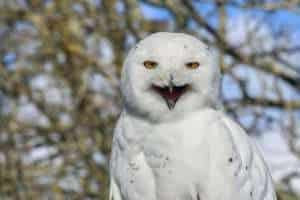
Snowy Owl (Bubo scandiaca)
Description
The snowy owl is an animal of the arctic that belongs to the animal class of a bird. It is a carnivore by virtue of its diet and has an average life span of 10 years in the wild. Its group name is called a blizzard and it ranges in size from 20 – 28 inches for the body and 4.2 to 4.8 feet for the wingspan. The snowy owl weighs 3.5 to 6.5 pounds and has a ghostly white plumage that reflects its Arctic origins with young owls, particularly males, becoming whiter as they grow older. Females on the other hand are darker than males, with dusky spotting, and they are never completely white. Some elderly males do turn completely white, but many still have flecks of dusky plumage.
Habitat
This animal of the arctic can spend the entire year in its northern breeding grounds, but can also migrate to Canada, the northern United States, Europe, and Asia.
Behavior/Diet
The snowy owl is a stoical (patient) hunter who perches and waits for its prey to be identified before flying high off in pursuit. Snowy owls have excellent vision and hearing, which allows them to locate prey that is hidden beneath thick vegetation or snow cover and use their sharp talons to catch their prey. A snowy owl’s favorite food is lemmings and an adult may consume over 1,600 lemmings per year or three to five per day. Rabbits, rodents, birds, and fish are the other animals on its menu that supplement its diet.

Beluga Whale (Delphinapterus leucas)
Description
This is another type of animal in the artic that belongs to the mammalian class and this animal has an average lifespan of 35 to 50 years in the wild. The beluga whale ranges from 13 to 20 feet in size and this huge size comes with a weight of 1 to 1.5 tons (that is equivalent to the size and weight of a school bus.). Belugas are also known as white whales, and their distinctive color makes them one of the most well-known and easily identified of all whales. The baby beluga whales are called calves and they are birthed gray or even brown and only turn white when they reach sexual maturity around the age of five.
Diet
This animal is a carnivore based on its feeding habit, eating mostly fish, crustaceans, and worms.
Behavior
Belugas typically live in a tiny group commonly known as pods and they are social animals and also very vocal communicators who use a variety of clicks, whistles, and clangs. These whales are commonly found in the coastal waters of the Arctic ocean, but they can also be found in subarctic waters.

Arctic Hare (Lepus arcticus)
Description
This is an animal of the arctic that is part of the mammalian class of the animal kingdom and this animal is an omnivore based on its feeding habit and diet. The arctic hare weighs 6 to 15 pounds and its size ranges from 19 to 26 inches for the head and body and 1 to 3 inches for the tail.
Hares are slightly bigger than rabbits, with taller hind legs and longer ears, and arctic hares, like other hares and rabbits, are fast and can run at speeds of up to 40 miles per hour. They have a brilliant white coat in the winter, which provides excellent camouflage in the land of ice and snow. The white coat changes in the spring and this makes them camouflage in the spring to resemble local rocks and vegetation in order to pounce on prey and hide from predators.
Habitat/Behavior
The harsh environment of the North pole is home to the arctic hare and these hares don’t really hibernate, but instead, adapt to the dangerous cold through a variety of behavioral and physiological adaptations. The presence of thick fur and a low surface area to volume ratio, are some of the physiological adaptations which help them conserve body heat. On the behavioral adaptation, these hares will dig snow shelters and huddle together for warmth and help them tolerate the Arctic tundra biome.
Arctic hares can be solitary at times, but they can also be found in groups of dozens, hundreds, or even thousands of their kind. Unlike many other mammals, arctic hares disperse rather than form groups during mating season. The animals form pairs and establish mating territories, although a male may choose more than one female partner producing one liter per year.
This polar animal can be seen at the gateway to the arctic national park in Alaska.
Diet
This animal of the arctic stays alive by eating woody plants, mosses, and lichens that it digs through the snow to find in the winter. Other times of the year, they eat buds, berries, leaves, roots, and bark.

Arctic Tern (Sterna paradisaea)
Description
The arctic tern is a carnivorous bird and another member of the arctic animals found in the north pole. It has an average lifespan of 20 years in the wild and this arctic animal weighs 3 to 5 ounces and has a size of 13 to 14 inches. This animal of the arctic is characterized by a bright red beak and feet, with its body covered in gray and white feathers with a black feather cap on top.
Diet
These arctic animals are extremely efficient at catching and eating prey, which contributes to their ability to fly so far in such a short period of time. These seabirds swoop through the air in search of food mostly fish, but also insects and crustaceans on the surface below. Then they dive into the water to catch their prey, which they can even enjoy while gliding in the water.
Behavior
The arctic tern is an excellent migratory bird, traveling from the Arctic Circle to the Antarctic Circle every year. One particularly dedicated tern traveled nearly 60,000 miles or more than twice the circumference of the Earth, hence they hold the world record for the longest migration performed by any animal. Terns travel thousands of miles by meandering across oceans and continents rather than flying north or south. These polar animals are so light, with their small bodies, short legs, and narrow wings. These characteristics enable them to float through the air on a breeze.
Habitat
Arctic terns can be found almost anywhere, as their migrations take them to every ocean and continent. These polar animals breed on the coasts and tundra of Europe, Asia, and the North American Arctic and subarctic regions, then follow the sun and fair weather on their yearly journey to the Antarctic Circle, which takes a couple of months.
Threats
Climate change is one of the most serious threats to these animals of the arctic. According to the International Union for Conservation of Nature, which has listed Arctic terns as a threatened species, these birds are expected to lose 20 to 50 percent of their habitat due to temperature changes caused by climate change.
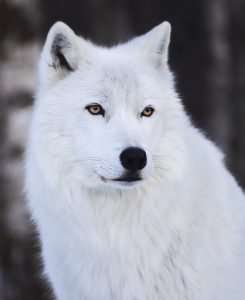
Arctic Wolf (Canis lupus arctos)
Description
The Arctic Wolf (also known as Polar Wolf or White Wolf) is an animal that is found in the north pole. This animal spends its entire life above the northern tree line in North America and the Arctic tundra found in Greenland. These animals of the arctic move in packs and they belong to the mammalian class in the animal kingdom and they weigh about 32 to 70kg and in the wild, Arctic wolves can live for 7 to 10 years. The polar wolves range in size of about 3.2 – 5.9 feet.
Behavior
Only the top-ranking alpha and beta females in a pack will be allowed to mate and reproduce. This ensures that potentially scarce food resources at the critical time are not spread too thinly across too many pups (normally 12 pups), potentially resulting in the death of all or any of them. Where this is possible, arctic wolves usually give birth in ready-made dens in rocks, caves, or those dens dug by other wolves in previous years. But there are cases where they may dig a den into the ground or snow to give birth.
Diet
They have a feeding habit of eating other animals of the food chain (they are carnivorous). Either an animal of the primary or secondary consumers. A diverse range of food sources for this arctic animal and the majority of which are large herbivores such as moose, caribou, deer, elk, and so on. The smaller prey animals, as well as livestock, carrion, and garbage, are eaten by arctic wolves making them opportunistic predators.
Habitat
The arctic wolf can survive in some of the coldest places on the planet thanks to a variety of anatomical, behavioral, and physiological adaptations. An example of this adaptation is that of them having seasonal furs that enable them to camouflage as animals in whatever season they are in.
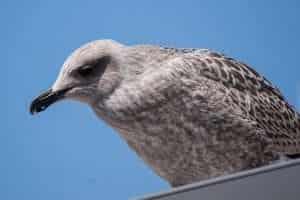
Arctic Skua (Stercorarius parasiticus)
Description
This is another animal of the artic and it weighs 12 to 20 ounces. The arctic skua has a body size of 16 – 18 inches and a wingspan of 43 to 49 inches.
Behavior/Diet
The skua is a carnivorous bird, feeding on fish and many more animals. These ferocious seabirds are also known as avian pirates because skuas steal a large portion of their food from terns, puffins, and other birds that are returning with fish or other prizes to their nests and young. Skuas attack in midair, pressuring their victims to lose their kills in midair and these swashbuckling birds sometimes work together to overwhelm their prey, and they are unrelenting in the pursuit of their foes. Arctic skuas are known as parasitic jaegers in North America and this tongue-twisting name explains both aspects of the animal’s feeding philosophy. Their feeding philosophy is kleptoparasitism and jaeger ( kleptoparasitism refers to the practice of stealing food from other species, and jaeger is derived from the German word hunter).
Although some skuas make their living solely through piracy, others use it only occasionally. Those that do hunt, put their hunting skills to the test while breeding ashore in the Arctic by preying on eggs, small birds, fish, and small mammals.
Habitat
Arctic skuas spend the majority of their lives at sea, only coming ashore to breed during the Arctic summer. When young jaegers leave the nest, they may not return to land for two years, or until they reach breeding age. Parasitic jaegers are excellent travelers who migrate to the Southern Hemisphere for the winter.
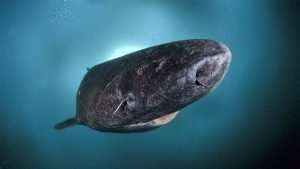
Greenland Shark (Somniosus microcephalus)
Description
This great animal of the arctic aquatic environment weighs up to 1.5 tons and can reach a size of about 8 to 14 feet, but there are occasions where it can reach up to 23 feet in size. It is known to be the longest and oldest animal in the world with an average lifespan of 400 years in the wild with a carnivorous appetite.
The world’s longest-living vertebrate is the Greenland shark because its lifespan is twice as long as the oldest land mammal, the giant tortoise. The Greenland shark is also known as the gray, ground, gurry, or sleeper shark that lives in extremely cold, deep waters, and this animal is one of the slowest of all the sharks. Greenland sharks are dark gray, brown, or black in color, with a cylinder-shaped body, small eyes, a rounded snout, and with no anal fin.
Habitat
The Greenland shark is the largest fish in the Arctic Ocean and the only shark found there all year. It also lives in the North Atlantic and the Russian high Arctic and is rarely seen at the surface of the water. The gray shark can live in waters as deep as 7,200 feet and ranging in temperature from 28.4 to 44.6 degrees Fahrenheit (-2 and 7 degrees Celsius). This shark’s tissues are specially adapted for cold water and contain high levels of chemical compounds that act as anti-freeze, which prevents ice crystals from forming in the body. These sharks conserve energy by swimming slowly about 1.12 feet per second but can ambush prey with short bursts of speed.
Diet
Greenland sharks have narrow, sharp upper teeth and wider, squared lower teeth and they roll their heads in a circular motion, holding large prey in place with their upper teeth and using their lower teeth like a blade to tear off circular chunks of flesh. While smaller prey is consumed whole. Greenland sharks are primarily scavengers and eat a wide variety of fish, squid, carrion and they may be opportunistic hunters capable of ambushing seals in stealth attacks.
Threats
Because of a parasite called Ommatokoita elongata, Arctic Greenland sharks frequently have poor vision. With each infection, this tiny crustacean latches onto the shark’s eye, damaging the cornea and leaving scar tissue. The shark’s blindness does not hinder its ability because it relies heavily on other senses in its dark habitat deep beneath the ice.
The animal is vulnerable to threats such as fishing, pollution, and climate change due to its slow growth rate, late maturity, and low reproduction rate.

Moose (Alces alces)
Description
This mammalian arctic animal is usually found in groups known as herds and they have a lifespan of 15 to 20 years in the wild normally seen at the gate of the arctic national park. This big animal of the arctic has a size of 5 to 6.5 feet in height at the shoulder and weighs 1800 pounds.
The moose as part of the animals that live in the artic is the largest of the deer species and males are distinguished by their massive antlers, which can span 6 feet from end to end. Moose have protracted muzzles that dangle over their chins and a bell-shaped flap of skin sways beneath each throat of the moose.
Diet
This polar animal is a herbivore and because of its height, it prefer to browse higher grasses and shrubs because it is difficult for them to lower their heads to ground level. They eat shrubs and pinecones in the winter, but they also scrape snow with their large hooves to clear areas for moss and lichen browsing. These hooves also serve as snowshoes, supporting the heavy animals in soft snow as well as muddy or marshy terrain.
Behavior
Each September and October, males, known as bulls, bellow loudly to attract mates and normally solitary bulls may band together at this time to compete for mating supremacy with their antlers. After mating, the two sexes split up until the following year, and though they may feed on the same grounds on occasion, they generally ignore each other. In the spring, females give birth to one or two calves, each weighing about 30 pounds, and these calves grow quickly and can outrun a person by the age of five days. Young moose remain with their mothers until mating season the following year.

Arctic Reindeer/Caribou (Rangifer tarandus)
Description
This animal of the arctic is a member of the mammalian class in the animal kingdom with an average weight of 60 to 300 kg and an average body size of 5.3 to 6.6 feet. It has a 6 – 8 inches tail size and an average height of 2.6 to 4.9 feet at the shoulder. This arctic animal has an omnivorous feeding mode with thick furs for easy adaption in the harsh North pole conditions. Females are relatively small than males, though the extent of the difference varies by subspecies; domesticated reindeer have shorter legs and weigh more than wild reindeer/caribou.
Habitat
The majority of the species of this animal of the arctic live above the northern tree line in the Arctic tundra, but they can also be found on many arctic islands. In Finland and Siberia, woodland reindeer can be found in the forests.
Behavior
Males compete for females during mating season, which lasts from late September to early November. Most encounters between males are resolved at a distance without physical contact, though this does occur when a pair of males both believe they are the strongest by locking antlers and pushing. During this time, a successful male may mate with 15-20 females. Because dominant males must maintain constant vigilance against other males during the mating season, they have little time to eat and lose a large portion of their stored reserves. A male may only be able to exhibit this level of dominance for one season in his life when he is large enough, around the age of six.
Diet
Reindeer eat sedges, grasses, herbs, ferns, and mosses on the tundra in the summer and when available, they will also consume tree shoots and leaves, with willow and birch being favorites. They have been identified as opportunistic carnivores, consuming lemmings, bird eggs, and arctic char (fish).
During the winter, they eat almost entirely lichens and fungi, which they often obtain by sweeping snow and ice away with their antlers and/or hooves. This polar animal is the only mammal with an enzyme called lichenase, which allows them to break down tough lichens and release glucose.
Threats
Reindeer are primarily preyed upon by wolves, who hunt them in packs, especially during the winter. Calves are preyed on heavily by golden eagles and sea eagles, but also by wolverines and, less commonly, brown bears and polar bears.

Bald Eagle (Haliaeetus leucocephalus)
Description
This polar animal of the arctic is a carnivorous bird with an average lifespan of 28 years in the wild. It is characterized by a body size of 34 to 43 inches and a wingspan of 6 to 8 feet. This north pole animal weighs from 6.5 to 14 pounds and it soars high above the cloud. Although this animal in the arctic does not have a bald head, rather it has a snowy feathery head and a whitetail, and it is the proud symbol of the United States of America. Though their numbers have increased across much of their scope, bald eagles are still most common in the gate of the arctic national park in Alaska and Canada.
The immature eagles are dark, and they lack the distinctive white markings that allow their parents to be identified until they are about five years old.
Diet/Habitat
These powerful birds of prey utilize their own talons to fish, but they also get a lot of their food by scavenging carrion or stealing the kills of other animals. They prefer to live near water and prefer coasts and lakes with plenty of fish, however, they will also trap and eat small mammals.
Behavior
Bald eagles mate for life and each year, a pair builds an enormous stick nest, one of the largest in the bird world, high above the ground and cares for a pair of eggs. Young eagles can travel long distances, for example, Florida birds have been spotted in Michigan, and California eagles have been spotted as far north as Alaska.
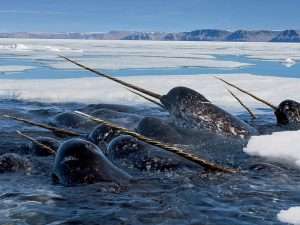
Narwhal (Monodon monoceros)
Description/Habitat
This mammalian polar animal of the arctic has a size of 13 to 20 feet and weighs 1.5 tons, equivalent to the weight of a bus. This north pole animal has a carnivorous diet and travels in groups. It is a pale-colored porpoise found in Arctic coastal waters and rivers, and the narwhal is commonly called the unicorn of the sea. These mythical creatures have two teeth and the more prominent tooth in males develops into a swordlike, spiral tusk up to 10 feet long. The ivory tusk tooth penetrates the narwhal’s upper lip and it is likely that tusk functions in mating rituals, possibly to impress females or to battle rival suitors. Females may develop a small tusk of their own, but it is not as noticeable as that of males.
Behavior/Diet
Bottlenose dolphins, belugas, harbor porpoises, and orcas are all related to narwhals and they travel in groups, like other porpoises, and feed on fish, shrimp, squid, and other aquatic fares. Narwhals are typically seen swimming in groups of 15 to 20, but large gatherings of hundreds, if not thousands, of narwhals, have been reported.
Threats
These groups are sometimes trapped by shifting pack ice and fall prey to Inuit (locals of the arctic) hunters, polar bears, or walruses. Narwhals are hunted by Inuit for their long tusks and skin, which is a good source of vitamin C in the traditional Arctic diet.

Canada Goose (Branta canadensis)
Description
Canada goose is a bird in the arctic that travels in a group called a flock. This polar animal has a herbivorous mode of feeding and a body size of 30 to 43 inches, with a wingspan of 4.2 to 5.6 feet. It weighs 6.6 to 19.8 pounds and has an average lifespan of 24 years in the wild.
Habitat/Diet
The omnipresent Canada goose is one of North America’s most well-known birds and it can be found in every contiguous United States state and every Canadian province at some point during the year. Canada geese as part of the animals that live in the arctic are adaptable to a wide range of habitats and can thrive wherever grasses, grains, or berries are present.
Behavior
Whenever the birds migrate, they form stunning and aerodynamic “V-formations.” They can travel 1,500 miles in 24 hours with a favorable wind, but they usually travel at a much slower pace. These raucous crowds honk their way along established paths with designated “rest stops.” Except when nesting, these social birds remain in flocks all year. Many Canada (not “Canadian“) geese have begun to change their migration patterns as a result of changing weather, settlement, and farming patterns.
Canada goose populations resurrected from a dwindling number at the turn of the twentieth century as a result of success in the protection program of the birds. The birds were legally protected and even reintroduced in areas where their numbers had declined. Today, geese are a popular game bird, and some management concerns revolve around keeping populations in check due to their negative impact on crops.
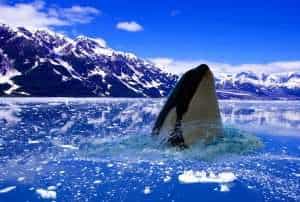
Orca (Orcinus orca)
Description
This mammalian polar animal is also called a killer whale, and it always travels in a group called a pod. It is a highly social animal with a size of 23 to 32 feet and a weight of up to 6 tons. This arctic animal has an average lifespan of 50 to 80 years in the wild with a carnivorous diet plan. These aquatic animals of the arctic are the biggest of dolphins and one of the most powerful predators on the planet, and they are easily identified by their distinctive black-and-white coloring.
Habitat/Diet
Orcas can be found from the polar regions to the Equator, though they prefer cold, coastal waters. These arctic animals are at the top of the aquatic food chain and eat a wide variety of prey, including fish, penguins, and marine mammals such as seals, sea lions, and even whales. They have been observed grabbing seals right off the ice with teeth up to four inches long. Orcas hunt in deadly pods, which can number up to 40 individuals and appear to have both resident and transient pod populations. The two groups as mentioned above may prey on different animals and use various methods to catch their prey, for example, the resident pods prefer fish, whereas the transient pods prefer marine mammals. All pods employ effective, cooperative hunting techniques that have been compared to wolf pack behavior.
Behavior
Orcas are intelligent and social aquatic polar animals and they make a wide range of communicative sounds. Each pod has distinct noises that its members can recognize even from a distance. They communicate and hunt using echolocation, which involves making sounds that travel beneath the water until they meet objects, which then rebound, disclosing their location, size, and shape.
Orcas are fiercely protective of their young, and other adolescent females frequently help the mother care for them. After a 17-month pregnancy, mothers give birth every three to ten years and they have one baby at a time, whom they nurse for up to two years. The bond between the juvenile and its mother will eventually weaken, and the young orca will go its own way, but in some pods, the juvenile can either spend its entire life with the pod into which it was born or not. In general, the orcas are known to be a close-knit family with skills being passed down from the older generation to the younger generation.
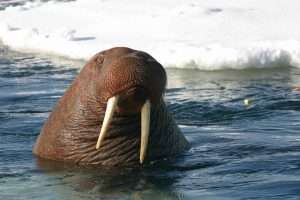
Walrus (Odobenus rosmarus)
Description
The walrus is a polar animal of the arctic that belongs to the mammalian class in the animal kingdom. It is a carnivorous arctic animal and it travels in groups called a herd. This giant north pole animal weighs up to 1.5 tons and has a size of 7.25 to 11.5 feet. The average lifespan of the animal in the wild is up to 40 years. This long-tusked and mustached animal in the arctic is most frequently seen near the Arctic Circle, lying on the ice with hundreds of others. They are physically characterized by their long white tusks, grizzly whiskers, flat flippers, blubber-filled bodies, and wrinkled brown and pink hides. Their tusks, which can grow to be three feet long and are found on both males and females, are actually large canine teeth that grow throughout their lives.
Behavior
They are extremely social, frequently bellowing and snorting at one another, but they become aggressive during mating season. Walruses utilize their famous long tusks for a variety of purposes, all of which help them survive in the Arctic. They use them to haul their massive bodies out of frigid waters, hence the “tooth-walking” nickname, and to drill breathing holes into ice from below. Male walruses, or bulls, use their tusks fiercely to uphold territory and to protect their harems of females, or cows, during mating season.
The walrus other distinguishing characteristics are also beneficial for example, walruses use their extremely sensitive whiskers, known as mustacial vibrissae, as detection devices for their favorite foods. Because their favorite foods, particularly shellfish, are found near the dark ocean floor. Walrus blubbery bodies allow them to live comfortably in the Arctic region and they can slow their heartbeats to tolerate the polar temperatures of the surrounding waters.

Snowshoe Hare (Lepus americanus)
Description
This polar animal is characterized by its 16 to 20 inches body size and it weighs from 2 to 4 pounds. It falls under the mammalian class in the animal kingdom and has an average lifespan of up to 1 year in the wild.
Rabbits are slightly smaller than hares, with shorter hind legs and smaller ears. Snowshoe hares have large, furry feet that allow them to move around on snow in the winter. They also have a snow-white winter coat that turns brown each spring when the snow melts and the coat takes about ten weeks to completely change color. The changing of the coat from white to brown and from brown to white aids the snowshoe hare to camouflage effectively in its environment.
Habitat/Diet
This arctic animal has a herbivorous feeding habit and they dwell in forest and bushy areas of the tundra. They are predominantly a northern species that live in boreal forests but can also be found as far north as the Arctic Ocean shores. They can be noticed as far south as Virginia (the Appalachians) and New Mexico along with North American mountain ranges where elevation simulates the environment of more northern latitudes (the Rockies). Snowshoe hares forage at night, following well-worn forest paths to eat trees and shrubs, grasses, and plants.
Behavior
These animals are quick and agile, which is fortunate because they are a popular prey item for many predators like the lynx, fox, coyote, and even some birds of prey.
Snowshoe hares, like most rabbits, are prolific breeders and females have two or three litters per year, with one to eight young per litter. Young hares known as leverets, require little care from their mothers and can survive on their own for a month or less. Snowshoe hare populations fluctuate cyclically about once every ten years, possibly due to disease. These fluctuating numbers have a significant impact on the animals that rely on hares for food, particularly the lynx.

Spotted Seal (Phoca largha)
Description
The spotted seal is a member of the mammalian class in the animal kingdom with a carnivorous diet. It has a body size of 4.5 to 5.5 feet for adults. This polar animal has an average lifespan of 30 to 35 years, with an average weight of 140 to 250 pounds for a fully grown adult. It is named after its coat pattern, which is typically a light background with dark spots. Spotted seals are unique among true seals because they form family groups comprising of a female, a male, and a pup each year during the breeding season.
They have a round head, narrow snout, and small body, as well as narrow, short flippers. Adult spotted seals are silvery-gray to light gray with dark spots scattered densely on their body and males and females are generally similar in appearance. The young ones called pups are born with a white coat that is usually shed at the time of weaning and replaced with a coat that is rather similar to adults.
Habitat/Behavior
Spotted seals tend to favor arctic or subarctic waters and are frequently found near the edges of shifting ice floes and they are common on the continental shelves. They rarely live in areas with dense pack ice and during the breeding season, spotted seals primarily haul out on ice floes, but they can also be found in the open ocean or hauled out onshore during the summer months. Spotted seals are not deep divers and spend almost all of their time feeding on the continental shelf in waters less than 650 feet deep.
Diet
Spotted seals eat a wide variety of prey, mostly fish, but also crustaceans and cephalopods with pups eating more crustaceans, while older seals eat more fish.

Sea Otter (Enhydra lutris)
Description
The sea otter is part of the animals that live in the arctic and it is a member of the mammalian class in the animal kingdom. This polar animal has an average lifespan of 23 years in the wild. The sea otter is 4 feet in body size and weighs 65 pounds. They are also characterized by having webbed feet, water-repellent fur, and nostrils and ears that close in the water to keep them dry and warm.
Habitat
This aquatic representative of the weasel family can be found along the Pacific Ocean’s coasts in North America and Asia because it spends the majority of its time in the water, but in some areas, it will come ashore to sleep or rest.
Behavior
Sea otters frequently float on the surface of the water, resting on their backs in peaceful repose. They sleep in this manner, often in groups, and these aquatic otters do something other than sleep on their backs as they are frequently seen with a clam or mussel and a rock snagged from the ocean floor.
Sea otters give birth in the water and the mothers care for their children while floating on their backs. The young ones are taught how to swim and hunt at an early stage as they swim on the chest of their mothers.
Sea otters are extremely clean, because they wash their bodies in the ocean after eating, cleaning their coat with their teeth and paws. They have a good reason to care for their coats because it keeps them waterproof and warm in the winter and the thick underfur traps air and acts as an insulator against the cold waters.
Diet
This arctic animal has a carnivorous diet as otters are observed to smash shellfish against small rocks that they hold on their chest until the shellfish breaks open, revealing the tasty meal inside. They also eat sea urchins, crabs, squid, octopuses, and fish, among other aquatic creatures.

Ringed Seal (Pusa hispida)
Description
This mammalian animal in the arctic is characterized by a body size that is up to 5 feet and a weight that reaches 150 pounds. It has a carnivorous diet and is always found in a group called a colony. This north pole animal has an average lifespan of 40 years in the wild.
Habitat/Diet
Ringed seals are the most common and widely distributed seals in the Arctic, living in the circumpolar oceans of the Northern Hemisphere and feeding on polar and arctic cod as well as a variety of planktonic crustaceans.
Behavior
The ringed seals spend the majority of their time near the ice edge but occupy areas much farther from the ice edge because of their ability to maintain cone-shaped breathing holes in the ice, which they excavate with the claws of their front flippers. Physiological adaptations allow them to dive deep and stay underwater for long periods of time up to 45 minutes, reaching depths of 300 feet. They do, however, occasionally blow bubbles up through their breathing hole before surfacing to check for polar bears, their main predator.
The only time these mostly solitary creatures congregate is on sea ice to breed, molt, and rest, staying close to breathing holes and cracks in the ice in case they need to flee quickly. They construct lairs (a type of snow cave) as soon as enough snow accumulates, becoming fiercely protective of them as well as the breathing holes and underwater areas beneath them.
Females reach sexual maturity around the age of six and implantation is delayed for several weeks after mating. The female then gives birth to one pup after a 9 to 11-month gestation period, raising it in the seclusion of a lair, they learn how to dive soon after birth. After the weaning of pups, they are left to fend for themselves. The females also shelter and shield the newborns from the harsh weather elements of the tundra and from predators.

Lemming (Lemmus lemmus)
Description
This mammalian arctic animal is characterized by a brown, gray, and white skin type that is covered with furs. The lemming is an animal of the tundra, with an herbivorous mode of feeding. It has an average weight of 30 to 112g with a top speed of 3mph and an average lifespan of 1-3 years. This animal has stout bodies and tiny limbs, tails, and ears, and the small ears aid in the conservation of body heat. They have razor-sharp teeth and claws to help them tear out and feed on roots. With their waterproof fur, these rodents are excellent swimmers, but it may be difficult for them to swim when multiple animals enter the water at the same time. Some lemmings drown as a result of the chaos and lack of extra space.
Lemmings are small animals that can grow to be 3-6 inches long and reproduce in less than a month. There are approximately 20 different types of lemmings. The tiniest of them measure only 8 cm in length and the largest of these species has been known to be three times the size of the smallest. True lemmings, collared lemmings, wood lemmings, bog lemmings, yellow steppe lemmings, and southern bog lemmings are among the six different subspecies of lemmings.
Habitat
Lemmings are found to be present in or near the Arctic Circle and are directly connected to muskrats and voles and they are also found in the Tundra biomes.
Diet
Lemming feeds on all kinds of vegetation that include twigs, roots, buds, sedges, mosses, barks, leaves, and seeds.
Behavior
When these animals sense danger, they become extremely aggressive toward their predators, sometimes getting into fights with larger animals. These rodents spend the majority of their summers underground and in various tunnels. Living underground and in tunnels allows them to survive harsh environments and eliminates the need for them to hibernate. It also shields them from large wild animals, which prey on them. However, as autumn approaches, the ground becomes cold and difficult to dig into, forcing them to come to the surface.
The lemmings also spend the majority of their lives alone and only come together when they need to mate.

Ermine (Mustela erminea)
Description
This polar animal is very fast with a top speed of 8 mph, and with a body size of 23 cm – 31 cm in length with the females typically slightly smaller than males. This animal of the arctic has an average weight of 60 to 110g, with a 7 to 10 years average lifespan in the wild. This species, also known as the stoat or the short-tailed weasel, is an important predator and prey animal in the ecosystem.
The ermine is characterized by a long body and neck, black eyes, short legs, round ears, and a rodent-like head with delicate whiskers that protrude from the sides. Its fur coat may be black, brown, or white in color with the changing of the seasons. The fur coat undergoes a remarkable transformation. For example, in the summer, it is brown and yellowish-white, and in the winter, it is almost pure white, and the tip of its tail is black.
Habitat
This member of the polar animals with a slender body lives in Eurasia and North America’s temperate and arctic regions.
Behavior
The small body size of the animal of the arctic is more than compensated for by its tenacious behavior, which includes sharp claws and teeth. Even much larger predators would be hesitant to attack an ermine. This north pole animal is not afraid to attack prey as large as itself, but it does necessitate a different hunting strategy. The ermine will seize these larger prey animals by the throat and bleed them to death. In comparison, to kill smaller prey, the ermine will sink its teeth into the base of the skull, killing it almost instantly.
Diet
Small mammals such as rodents, shrews, and rabbits make up the majority of the diet of this member of the polar animals. It also eats frogs, fish, insects, birds, eggs, and whatever other meat it can get its hands on.

Snow Goose (Anser caerulescens)
Description
This arctic bird is always found in groups called flocks, and it has an average body size of 27 to 33 inches and a wingspan of 4.5 feet. This polar animal is an excellent migrator with an average weight of 3.5 to 7.3 pounds.
Snow geese are recognized for their white plumage, but several of them seem to actually be blue geese, which are darker, gray-brown birds. These arctic birds were previously thought to be of 2 distinct species, but they have recently been discovered to be two different color morphs of the same bird. The color difference is controlled by a single gene.
Diet/Habitat
The snow goose has an herbivorous diet with more focus on agricultural fields found in the tundra biome. During the colder seasons, they spend lots of time in southern coastal marshes, bays, wet grasslands, and fields. Their diet consists wholly of grasses and grains grazed from moist soils or even murky water.
Behavior
These polar animals herald the arrival of the changing seasons as they migrate south for the winter in massive, honking flocks that can be seen as a “V” formation or merely as a huge “snowstorm” of white birds.
Snow geese migrate north to their breeding grounds on the Arctic tundra at the end of the winter. Pairs mate for life and lay two to six eggs in a shallow ground nest each year. When hatched, chicks can swim and eat on their own within the first 24 hours, but families stay together for the first winter. During both the southern and northern migrations, families can be identified as groups.

Puffin (Fratercula arctica)
Description
This is another bird of the arctic that lives in groups called colonies. These arctic animals are 10 inches in body size and weigh 17.5 ounces, Atlantic puffins have penguin-like coloration, but they have a colorful beak that has earned them the nickname “sea parrot” by some. The beak fades to a drab gray in the winter and blooms with color again in the spring, implying that it is appealing to potential mates.
They are strong swimmers who use their wings to fly underwater while swimming. These arctic animals can dive into depths of 200 feet and steer with rudder-like webbed feet, though they usually only stay underwater for 20 or 30 seconds. Puffins are surprisingly fast flyers in the air as they can reach speeds of 55 miles per hour by flapping their wings up to 400 times per minute.
Habitat/Diet
These birds spend the majority of their lives at sea, resting on the waves when they are not swimming. This member of the polar animals has a carnivorous appetite for small fish, herring, or sand eels.
Behavior
Each spring and summer, Atlantic puffins congregate on the North Atlantic seacoasts and islands to form breeding colonies. Iceland is the breeding ground for approximately 60% of the world’s Atlantic puffins. The birds frequently build their nests on precipitous, rocky cliff tops, which they line with feathers or grass. The single egg laid by the female bird is incubated by both parents. Whenever a chick hatches, its parents take rotations in feeding it by returning to the nest with small fish in their relatively large bills. Puffin couples frequently reunite at the same burrow site year after year. It’s unclear how these birds get back to their nesting grounds but they may rely on visual cues, smells, sounds, the Earth’s magnetic fields, or even the stars.

Dall Sheep (Ovis dalli dalli)
Description
This animal in the arctic tundra is famously known for its big horns. It is a mammal that weighs 117 to 300 pounds when fully matured, and it has an average body size of 5 to 6 feet. This animal of the tundra has an average lifespan of 6 to 15 years in the wild. It is also a herbivore like its cousins the sheep and goat.
These north pole animals are best known for their massive curled horns on the males also known as rams. While the females known as ewes have horns as well, but they are shorter, slenderer, and only slightly curved. The rams and ewes look alike when they are at a very young age. But when they reach 3 years, they can now be clearly distinguished from one another because of the continuous horn growth of the rams.
During the spring, summer, and early fall, horns grow steadily. Horn growth slows and eventually stops in the late fall or winter. This intermittent growth produces a pattern of rings called annuli that are spaced along the length of the horn and can be used to determine the age.
Behavior
In late May or early June, ewes give birth to lambs and as lambing season approaches, ewes actively seek out solitude and predator protection in the craggiest mountains in their spring ranges. The young lambs start eating vegetation about a week after birth and are usually weaned by October. Ewes typically have their first lamb around the age of three or four, and they have one lamb per year.
Habitat/Diet
Dall Sheep live in Alaska’s mountain ranges and their diet differs from range to range. For example, food is plentiful during the summer, where a wide variety of plants are consumed. Diet is much more restricted during the winter season, consisting primarily of dry, frozen grass and sedge stems accessible when snow is blown off winter ranges. During the winter, some populations consume a significant amount of lichen and moss. Many dall sheep explore the licking of minerals and often travel long distances to eat the soil at these odd geological formations in the spring.
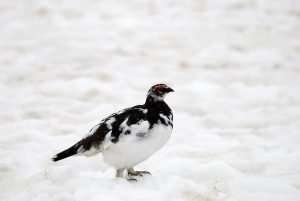
Ptarmigan/Lagopus (Lagopus lagopus)
Description
Lagopus is a small bird genus in the grouse subfamily known as ptarmigans. This arctic animal has three living species and numerous subspecies, all of which live in tundra or cold upland areas. This animal of the arctic weighs about 1.3 pounds and with a wingspan of 20 – 22 inches. This polar bird also has an average lifespan of 2 years. Except for the red grouse, all species and subspecies have white winter plumage that helps them blend into the snowy background, which means they are camouflaging animals in the winter.
Habitat
The 3 species are all sedentary (always spending much time in a seating position and inactive) cold-weather specialists. The poleward boreal forest is home to the willow ptarmigan or the lagopus, and the North American alpine forest is home to the white-tailed ptarmigan, whereas the rock ptarmigan breeds in both the Arctic and mountain habitats throughout Eurasia and North America.
Diet/Behavior
These are tough vegetarian birds have an herbivorous diet, that includes berries, twigs, and buds. But the young ptarmigan that is developing eats insects, except for the willow ptarmigan, where the female is entirely responsible for nesting and caring for the chicks, as is typical in gamebirds.

Wolverine (Gulo gulo)
Description
This mammalian arctic animal has an omnivorous feeding habit, with an average lifespan of 7 to 12 years in the wild. This polar animal has a head and body size of 26 to 24 inches and a tail that is 7 to 10 inches. The wolverine weighs approximately 24 to 40 pounds. This animal of the arctic is strong and looks like a small bear but is the largest member of the weasel family in terms of body size.
These animals in the arctic live alone and require a lot of space to roam, as individual wolverines can travel up to 15 miles per day in search of food.
Habitat
This polar animal prefers to live in remote boreal forests, taiga, and tundra in the northern latitudes of Europe, Asia, and North America due to the availability of space to roam.
Diet
The wolverine eats some vegetarian food in the summer, such as plants and berries, but it is not a large part of their diet, because they are feisty predators with a preference for meat. Wolverines use little effort to kill smaller prey like rabbits and rodents but will attack larger animals such as caribou if the prey seems to be weak or injured. These opportunistic omnivores also consume carrion, which is the carcasses of larger mammals like elk, deer, and caribou. Such finds keep them going during the winter, when other prey may be scarce, they may also dig into burrows and eat hibernating mammals.
Behavior
The males scent-mark their territories, but share them with multiple females, implying that they are polygamous. Each late winter or early spring, females den in the snow or under similar cover to give birth to two or three young known as kits. Kits may stay with their mother until they attain reproductive age, which is around two years old.
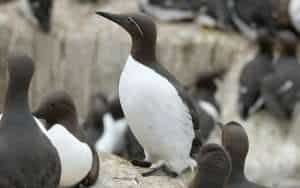
Brunnich’s Guillemot (Uria aalge)
Description
This species, known in Eurasia as the Common Guillemot and in North America as the Common or Thin-billed Murre. This arctic animal is a medium-sized dark brown and white seabird with a body length of 38–43 cm, and a wingspan of 64–71 cm, accompanied by a weight of 800–1,125 g.
Habitat
This animal is found in cooler, continental shelf waters of the sub-Arctic/low-Arctic and is one of the most numerous marine birds in the North pole.
Behavior
This polar animal is a skilled diver, for instance, the Common Murre dives to depths of more than 100 meters in search of small fish as well as invertebrates (such as euphausiids and cephalopods). It forages in flocks, including multispecies assemblages, most of the time. The murre’s relatively small wings, which are a compromise for underwater wing-propelled diving and aerial flight, necessitate rapid beats in order for it to stay aloft in the air. This high wing-loading, combined with diving in cool waters with poor insulation, contributes to an energy-inefficient way of life.
This highly social species breeds shoulder to shoulder on island cliff ledges, slopes, and flat surfaces; it has no nest but fiercely defends its egg-laying site or territory, which is little more than the space a pair occupies.
High-latitude populations migrate to avoid winter sea ice, particularly those breeding on the coasts of the Barents, Greenland, Chukchi, and Bering seas, as well as off the coasts of Labrador; mid-latitude populations are partially migratory, and lower-latitude populations are sedentary.
Diet
Fish, euphausiids, large copepods, and squid are examples of micronektonic prey that range in size from 2 to 25 cm (mostly 6–10 cm) that guillemot eat. Summer diet consists primarily of fish, especially when feeding chicks, as opposed to a more diverse diet during the non-breeding season, with euphausiids being especially important.
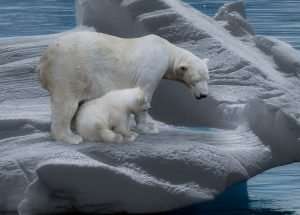
Polar Bear (Ursus maritimus)
Description
This arctic mammal has a carnivorous feeding habit with an average weight of 900 to 1600 pounds. This polar animal has a head and body size of 7.25 to 8 feet and a 3 to 5 inches tail size. It has an average lifespan of 25 to 30 years in the wild and is known for its white thick fur. The thick coated insulated fur covers a layer of fat that keeps them warm. The fur even grows on the bottoms of their paws, protecting them from cold surfaces and providing a firm grip on ice. The white-coated fur helps it blend in with the surrounding snow and ice and the black skin beneath their fur, allows them to soak up the warming rays from the sun.
They are excellent swimmers, with slightly webbed front paws that they use to paddle with some seen swimming hundreds of miles from land, though the majority of that distance is likely covered by floating on sheets of ice.
Habitat
Polar bears can be found roaming the Arctic ice sheets and swimming in the region’s coastal waters and they enjoy living in one of the world’s coldest environments. These Arctic colossi are masters of their surroundings and have no natural enemies.
Diet
These ferocious predators usually prey on seals and in their pursuit of this quarry, they frequent areas of shifting, cracking ice where seals may surface for air. They also prowl around ice edges and breathing holes in search of prey. Polar bears will consume carcasses, such as those of dead whales if the opportunity arises.
Behavior
Females make their dens by digging deep into snowdrifts that will provide protection and insulation from the Arctic weather elements. They usually have twins in the winter as young cubs spend 28 months with their mothers learning the survival skills of the far north. Females aggressively protect their young, but their solitary male mates offer no assistance as they may even kill their own offspring. Polar bears are powerful predators who do not fear humans, making them dangerous and they frequently develop a taste for garbage near human settlements, putting bears and humans in perilous proximity.

Musk Ox (Ovibos moschatus)
Description
This arctic animal belongs to the mammalian class in the animal kingdom, and it is characterized by plenty of hairs with a height of 4 to 5 feet at the shoulder. This polar animal has an herbivorous diet with a weight of 500 to 800 pounds. The musk ox has an average lifespan of 12 to 20 years in the wild. The outer hairs, known as guard hairs, protect a second, shorter undercoat that provides extra insulation in the winter. When the temperatures rise at the end of winter, this undercoat falls out.
Habitat/Diet
These animals have been living in the Arctic for thousands of years, and their long shaggy hair is well adapted to the cold climate. This arctic animal roams the tundra in search of the roots, mosses, and lichens that sustain them in the frozen arctic. In the winter, they dig through the snow with their hooves to graze on these plants. They supplement their diet with arctic flowers and grasses during the summer, often feeding near water.
Behavior
The musk ox is a herd animal that means they move in groups, and herds of two or three dozen animals are occasionally led by a single female. Female musk oxen carry their calves for eight months, but there is little time to waste after a birth. Within a few hours, the infants can keep up with their mothers and the rest of the herd.
To deal with wolf or dog predation, herds use cooperation and when they are threatened, they circle the wagon and line up with their young in the center and their sharp horns fully extended toward their enemies. A cornered musk ox can be deadly with its huge bulk horns.
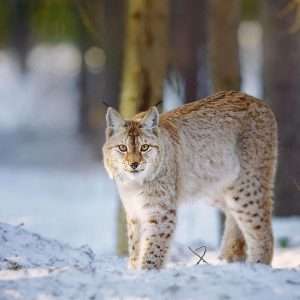
Lynxes (Lynx lynx)
Description
This mammalian wild cat is an animal in the arctic that weighs approximately 22 to 44 pounds and it has a carnivorous diet like the rest of the wild cat family. This polar animal has a head and body size of 32 to 40 inches and a tail size of 4 to 8 inches. Lynxes have magnificent thick fur that helps keep them warm during the cold winters. Their large furry paws spread when it hits the ground in a spreading toe motion, allowing them to operate as natural snowshoes.
Habitat
The lynx is a lone cat that lives in the far northern forests of North America, Europe, and Asia. Few species thrive in Europe, and even those that do are typically larger than their North American counterpart, the Canada lynx.
Behavior
These nocturnal cats avoid humans and hunt at night. Lynx (all species) are expert hunters with excellent hearing (the tufts on their ears serve as a hearing aid) and visual acuity so sharp that a lynx can spot a mouse from a distance (approximately 250 feet).
The lynx mate in late winter or early spring and females give birth to a litter of one to four young about two months later.
Diet
The snowshoe hare is preferred by Canada lynx over mice, squirrels, and birds as food, and the lynx is so reliant on this prey that their populations fluctuate in response to a ten-year decline in snowshoe hare numbers. In addition to small animals, larger Eurasian lynx hunt deer, and other larger prey.